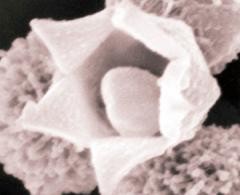
This Article From Issue
July-August 2011
Volume 99, Number 4
Page 303
DOI: 10.1511/2011.91.303
This roundup summarizes some notable recent items about scientific research, selected from news reports compiled in Sigma Xi’s free electronic newsletters.
Cave Bears and Art
France’s Grotte Chauvet houses what may be the world’s oldest cave paintings. Radiocarbon analyses date the pigments and nearby charcoal to more than 30,000 years ago. But artistically, the drawings look half that old. The debate about their age continues, but new evidence from bones of now-extinct cave bears (Ursus spelaeus) corroborates the paintings’ antiquity. In Chauvet and a nearby cave, mitochondrial DNA and radiocarbon analyses suggest the bears had low genetic diversity and disappeared from the region 28,000 years ago. Chauvet’s artists depicted cave bears, and they must have done so before the animals went locally extinct.
Bon, C., et al. Low regional diversity of late cave bears mitochondrial DNA at the time of Chauvet Aurignacian paintings. Journal of Archaeological Science (published online April 2)
A Greener Green
Green-colored pyrotechnics are a problem. They’re used in fireworks and hand-held military signal flares, but they emit toxic barium compounds and persistent organic pollutants. Until now, safer alternatives to barium have been too expensive or too fast-burning. Chemists may have found a solution: boron carbide (B4C), a cheap and common abrasive never before used in pyrotechnics. At high temperatures, it reacts to form the green-emitting boron oxide (BO2)—without the toxic pollutants. The new flares also burn brighter and 1.5 seconds longer than the military standard.
Sabatini, J. J., et al. Boron carbide as a barium-free green light emitter and burn-rate modifier in pyrotechnics. Angewandte Chemie International Edition 50:4624–4626 (May 9)
Six-Winged Insects
Treehoppers (Membracidae) are famous for their elaborate helmets, which can resemble seeds, thorns, feces or even ants. Entomologists long assumed that these structures, like beetles’ horns, were outgrowths of cuticle. But on closer inspection, researchers report that the insects’ helmets are actually homologous to wings. Both structures attach to the body with joints and express the same genes during development. Like a pair of wings, a helmet forms from two pads of embryonic tissue. No other insect lineage has sported a third set of wing-like appendages over the past 250 million years. It seems that membracids have revived a long-silenced ancestral trait and put it to spectacular use.
Prud’homme, B., et al. Body plan innovation in treehoppers through the evolution of an extra wing-like appendage. Nature 473:83–86 (May 5)
Linguistic Eve
Languages evolve so quickly that it’s hard to trace their ancestry more than about 6,000 years back. But a new study did so by stripping 504 modern languages down to their phonemes, the simplest sounds that convey meaning. (Miss and this differ by one phoneme.) The author found that African tongues had the most phonemes, whereas languages in South America and Oceania had the fewest. Thus, phonemic diversity, like genetic diversity, diminished along the path of prehistoric human migration away from Africa. This pattern suggests that a single mother tongue—spoken by the humans who left Africa more than 50,000 years ago—is the common ancestor of all languages spoken today.
Atkinson, Q. Phonemic diversity supports a serial founder effect model of language expansion from Africa. Science 332:346–349 (April 15)
Peacock Mystique
If peahens (Pavo cristatus) tally eyespots on their suitors’ tail feathers, they do a sloppy job. As long as a male displays about 140 spots in his gaudy train, extras do not improve his chance of mating. Previous experiments reached conflicting conclusions about peahens’ preference for eyespots, and a new study revisited this classic case of sexual selection. Researchers confirmed that, among feral peafowl in North America, snipping out 20 spots wrecked males’ prospects for mating. But few peacocks were naturally so plain. Most displayed 144 to 169 eyespots—and within that acceptable range, hens relied on some other cue (still unknown to science) to rank their suitors.
Dakin, R., and R. Montgomerie. Peahens prefer peacocks displaying more eyespots, but rarely. Animal Behaviour (published online April 12)
Ash Under Scrutiny
Iceland’s Eyjafjallajökull volcano disrupted European travel last April, when airlines shut down for a week to avoid the ash plume. Now a battery of chemical and physical tests backs up that decision. Earth scientists conclude that the ash particles were unusually sharp, and hard enough to sandblast and obscure cockpit windows. Their glassy composition and powdery texture would have also damaged planes by melting in the interiors of jet engines. Had the ash fallen out in high concentration, its chemical coating would have threatened drinking water and its small size would have posed a breathing hazard. The authors suggest that their straightforward procedures could be used to quickly assess the health and mechanical risks of future eruptions.
Gislason, S. R., et al. Characterization of Eyjafjallajökull volcanic ash particles and a protocol for rapid risk assessment. Proceedings of the National Academy of Sciences 108:7307–7312 (May 3)
Risky Meat?
Nearly half of meat in U.S. supermarkets is contaminated with the infectious bacterium Staphylococcus aureus, a recent study reports. Ninety-six percent of those bacteria are antibiotic-resistant and more than half can withstand at least three different drugs. Each kind of meat has its own signature S. aureus genotypes, suggesting that the bacteria originated with the animals themselves rather than with human handlers. Researchers drew these conclusions from 136 samples of meat and poultry—including five species and 80 brands—purchased from grocery stores in five cities. Although cooking kills even superbugs, their prevalence in food suggests that the public-health implications may warrant further study.
Waters, A. E., et al. Multidrug-resistant Staphylococcus aureus in US meat and poultry. Clinical Infectious Diseases 52:1227–1230 (May 15)

American Scientist Comments and Discussion
To discuss our articles or comment on them, please share them and tag American Scientist on social media platforms. Here are links to our profiles on Twitter, Facebook, and LinkedIn.
If we re-share your post, we will moderate comments/discussion following our comments policy.